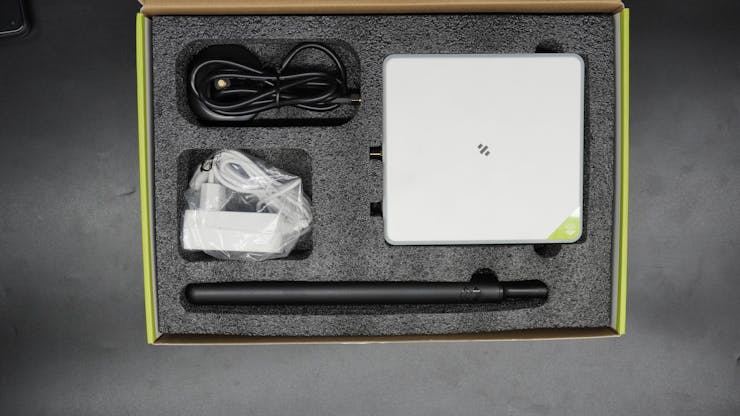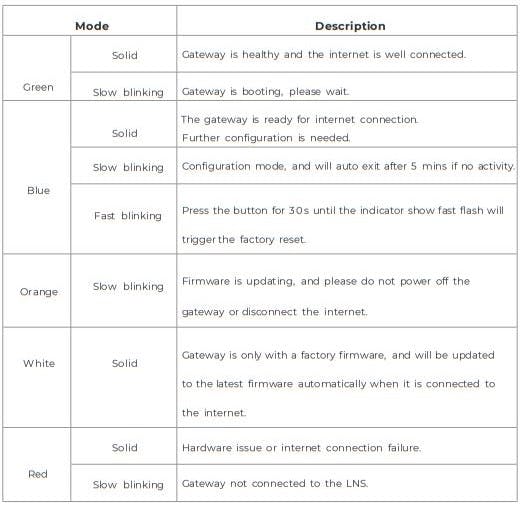In my initial foray into LoRa technologies, I developed a single-channel LoRa Gateway. This gateway was designed to connect with only one end node (Sensors) at a time. Communication with application servers was facilitated through Wi-Fi connectivity embedded within the gateway itself.
My Wi-Fi Backhaul single channel LoRa Gateway Project Link: https://www.hackster.io/vinayyn/single-channel-lora-gateway-using-wio-e5-lora-and-blynk-20b9ec
Ethernet Backhaul single channel LoRa Gateway Project Link:
https://www.hackster.io/vinayyn/ethernet-enhanced-lora-gateway-minimizing-delay-017503
After days of working on the project, I wanted to connect multiple End Nodes (Sensors) with significantly reduced power consumption. I updated them to the LoRaWan by modifying the firmware. When I started looking for a gateway to connect the multiple End nodes, I found that the gateway costs were too high and they did not fit into my budget.
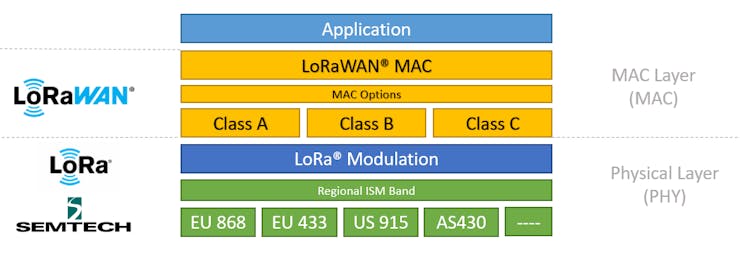
After conducting thorough research, I reached out to numerous manufacturers and distributors worldwide, only to discover that their gateway prices consistently fell around $500. They highlighted the outdoor compatibility and expansive coverage capabilities of their products. My investigation further revealed that all manufacturers utilized the Semtech SX130X baseband LoRa® chip for gateways, with antenna specifications tailored to regional ISM bands and operating ranges. Most of their products offered Wifi and Ethernet Backhaul exclusively. I concluded that these gateways were not suitable for outdoor implementation due to the need for a physical connection to the gateway. Subsequently, I identified a few gateways equipped with 2G/3G/4G support. However, these features came at an additional cost of $100-$300 USD, and their parameter specifications varied from country to country, rendering them incompatible in my region.
While scouring manufacturer and reseller websites, I stumbled upon SenseCAP products on the Seeed Studio website. The gateways' starting price was $99 for Ethernet and Wi-Fi backhaul and $149 for Wifi, Ethernet, and 2G/3G/4G Support. I then contacted a member of their technical team to inquire about 4G band compatibility in India. The team provided me with the necessary details, prompting me to reach out to an Indian network operator for their technical specifications.

EU868 4G Version Suppotive Bands
Upon signing an NDA with the network provider, they furnished the requested details. However, further investigation revealed that this information was readily available on the Indian Govt's Telecommunication portal. The results were favorable as the SenseCAP Multi-Platform LoRaWAN Indoor Gateway(SX1302-4G) - EU868 aligned with the operating parameters.
Indian 4G Band Details "LTE-FDD:B1/B3/B7/B20 LTE-TDD: B40/B41"
Without hesitation, I procured the SenseCAP Multi-Platform LoRaWAN Indoor Gateway(SX1302-4G) - EU868 at $149, including $30 shipping and $90 Indian customs fees.
.
Get PCBs for Your Projects Manufactured
This project was successfully completed because of the help and support from NextPCB. Guys if you have a PCB project, please visit their website and get exciting discounts and coupons.
NextPCB offers high-quality, reliable PCB starting at $1.9, and multilayer starting at $6.9. Also, everyone can enjoy free PCB assembly for 5 boards! Also, NextPCB is having a year end sale in which anyone can register through their website and get a $30 Coupon which can be used for ordering PCBs.
You can also try HQDFM free online PCB Gerber viewer to check your PCB design and avoid costly errors.
Configuring the SenseCAP M2 LoRaWAN Gateway with 4G Backhaul for the IN865 Indian Frequency Band
Before configuring the gateway, it is essential to familiarize yourself with its specifications.
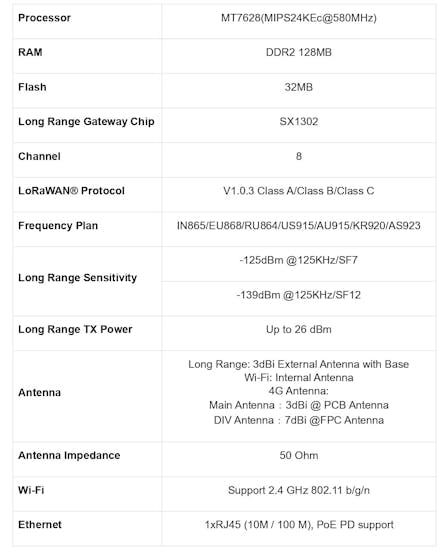
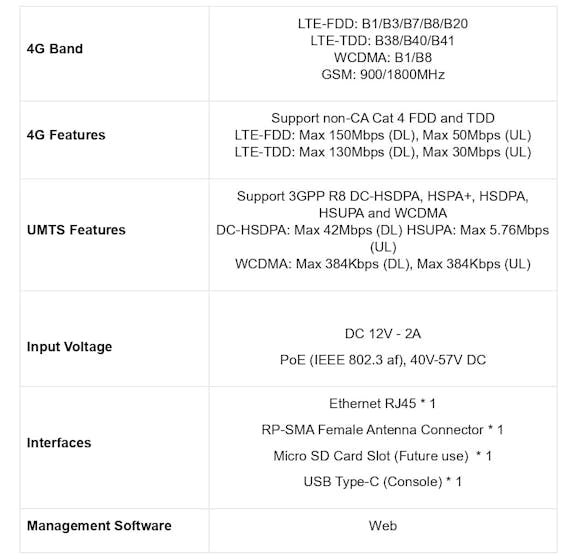

Key Features
Support Multiple LoRaWAN® Network Servers: Compatible with multiple LNS like AWS, TTN, ChirpStack, etc. via using the Packet Forwarder / Basics™ Station mode.Built-in LoRaWAN Network Server: Provide a fast and reliable solution for launching a LoRaWAN network.Support Power-over-Ethernet (PoE): For users who need to power the gateway on Ethernet instead of an extra power supply cable, the PoE feature is also added to this device, making your deployment more reliable and faster.Wide-range Coverage and Strong Signal: Provides up to 10km of LoRaWAN® coverage and strong signal, allowing users to send data with extremely long ranges at low data rates.Excellent and Stable Performance: The gateway is powered by the mature hardware solution MT7628 and Semtech SX1302 baseband Long Range chip. It supports Cellular(optional)、Wi-Fi and Ethernet internet connection.Professional Management Tools and Cloud Services: Users could easily set up the gateway in a few simple steps via Web Interface. SenseCAP Portal and SenseCAP Local Console are also developed for users to monitor and manage the gateway efficiently and easily.
Architecture
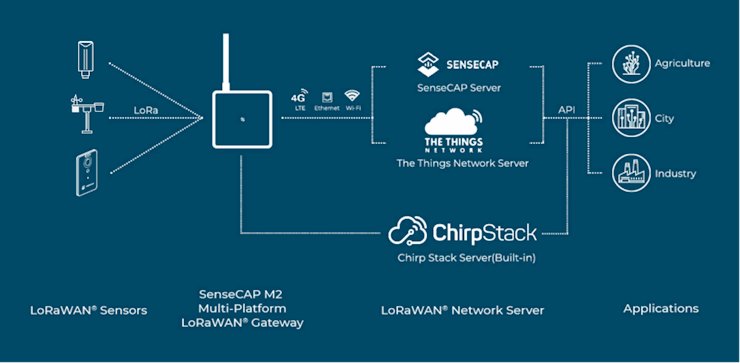
Interface
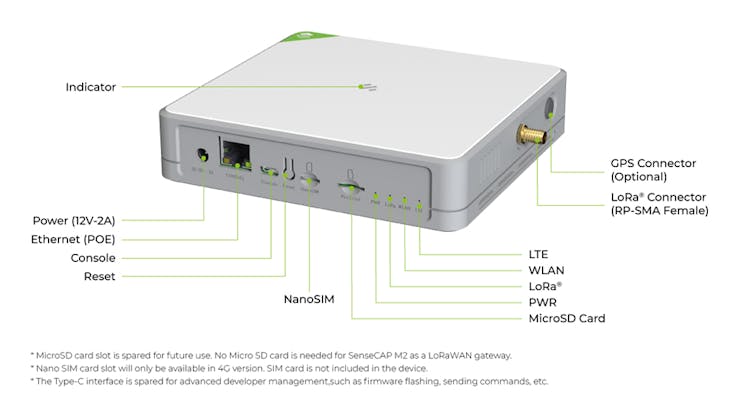
Now Iets configure the Gateway
SenseCAP M2 Multi-Platform LoRaWAN® Gateway can be configured in 2 ways: 1. Wi-Fi/ Ethernet access to the SenseCAP Local Console 2. Access the SenseCAP Local Console via SenseCAP Portal remotely
Here I will configure The Gateway using the AP hotspot
Step 1: Press the button for 5 seconds until the blue indicator flashes slowly to enter the
configuration mode.
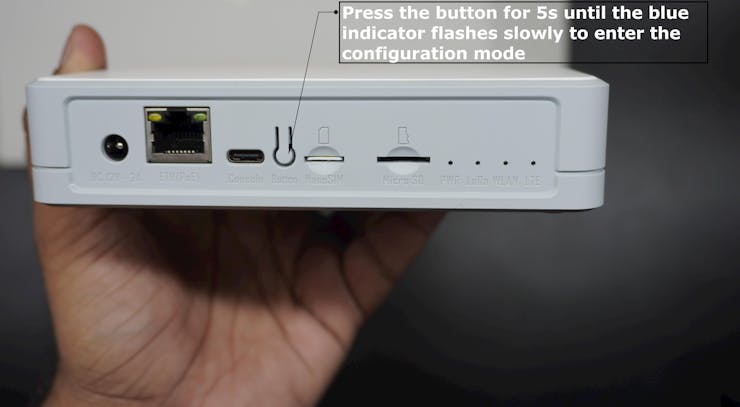
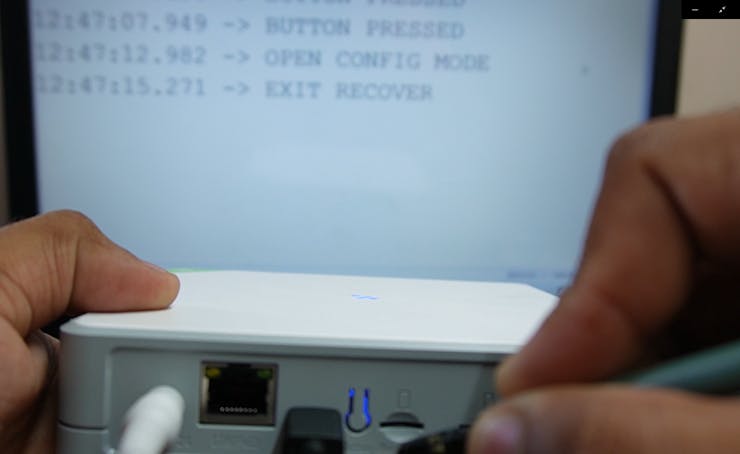
Step 2:Turn ON your Laptop/tablet/ Mobile/Wi-Fi, and scan for available networks. then search for the hotspot name SenseCAP_XXXXXX, and enter the default password 12345678; Once Connected, Find the IPV4 Address of your Device
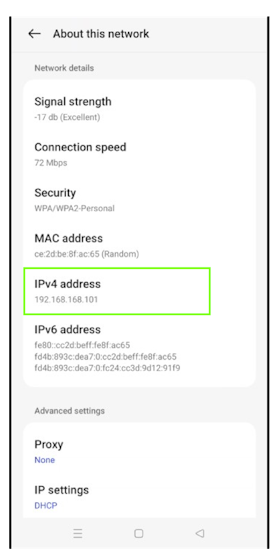
Step 3: Get your device Username and Password details from the back panel of the gateway device label.
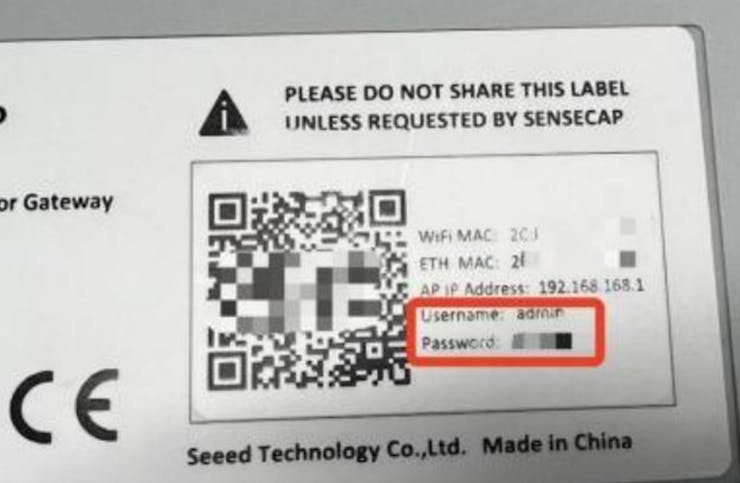
Step 4: Log into the Local Console by inputting the IP Address (192.168.168.1) in your browser to enter the Local Console. it is called asLuCi Console. Then input your device username and password, and click the Login button.

Wi-Fi Configuration
The indicator light located on the top of the gateway will illuminate solid green to indicate a successful connection to the Wi-Fi network.
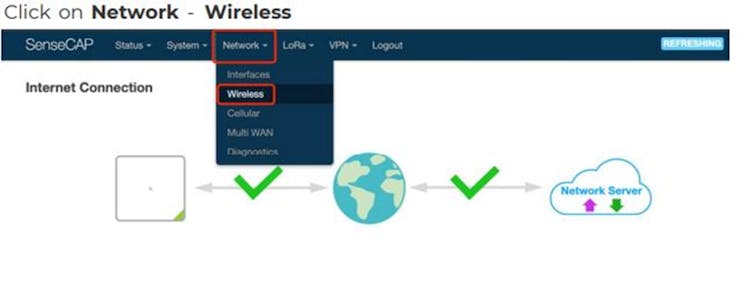
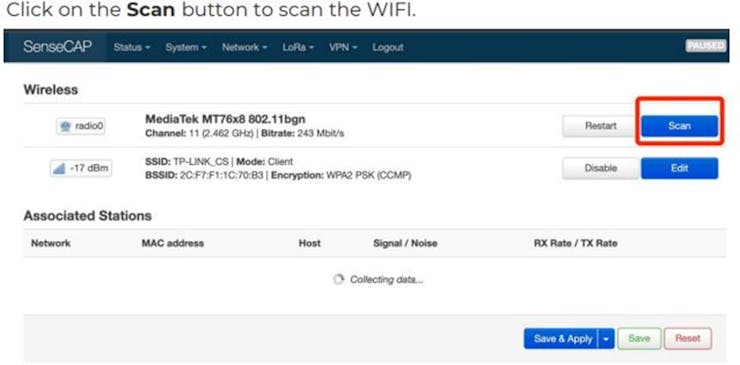



Cellular 4G Configuration
Step 1: Plug your SIM card into the Nano-SIM card slot.

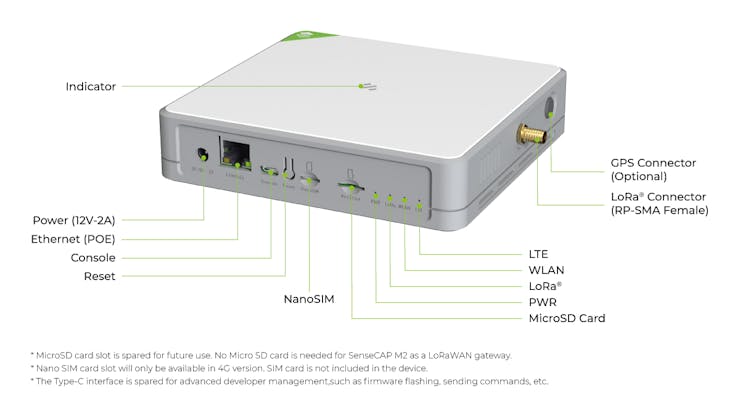
Locate the SIM card slot on your SenseCAP Multi-Platform LoRaWAN Indoor Gateway(SX1302-4G). It is typically found on the side or bottom of the device.
Power off the gateway.
Insert the SIM card into the SIM card slot. Ensure the SIM card is oriented correctly, with the gold-colored contacts facing down.Gently push the SIM card into the slot until it clicks into place.Power on the gateway.Verify the SIM card is detected. The indicator light will illuminate solid green to indicate a successful connection to the cellular network.
Step 2: Log in to the Lucipage, and click on Network - Cellular

Step 3: Set up the APN info, and click Save and Apply to apply your settings.
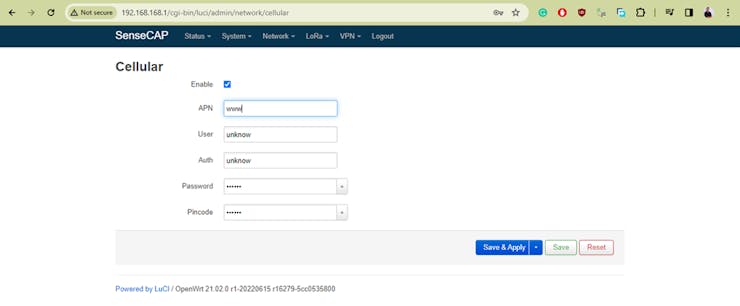
The default APN for Vodafone-Idea 4G Nano SIM is "www". However, the APN may vary depending on the service provider. It is always advisable to check with your service provider for the latest APN settings.
Once the changes are saved, the gateway will apply the updated settings.

LoRa Channel Plan Settings
Navigate to LoRa > Channel Plan
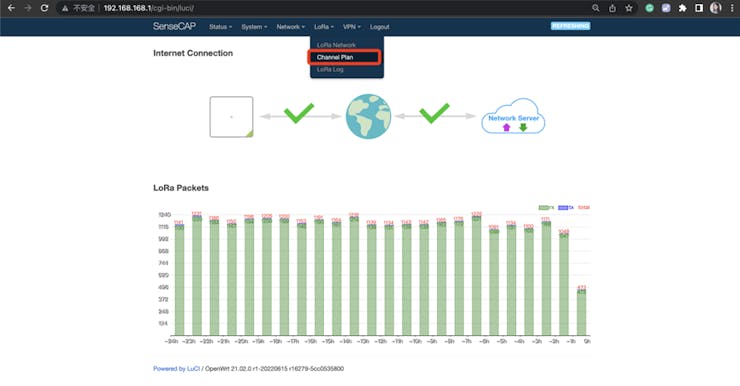
Select the Region and Frequency plan.


After setting, click Save&Apply
Connecting to TTN
There are two ways to connect to the Things Network: Packet forward and Basics™ Station. Choose a way to connect your gateway.
Semtech UDP Packet Forwarder is the original LoRaWAN® packet forwarder, connecting to servers through the Semtech UDP protocol.
LoRa Basics™ Station is the preferred way of connecting Gateways to The Things Stack.
Connecting via Packet Forwarders
The Semtech UDP Packet Forwarder is the original LoRaWAN® packet forwarder, connecting to servers through the Semtech UDP protocol.
TTN Configuration
Step 1: Log into The Things Stack. If you don't have a TTN account, please register first.
Step 2: Register the gateway
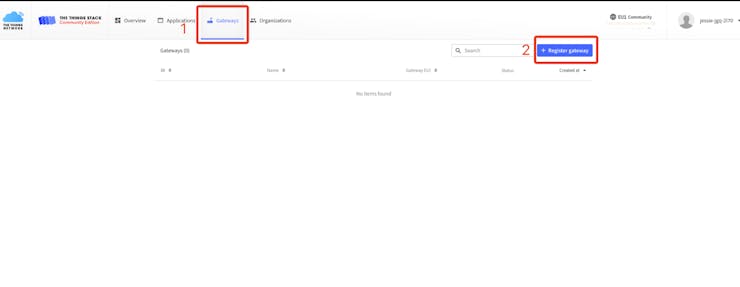
Gateway EUI: Gateway EUI can be found on the device label or Local Console
Gateway ID: A unique identifier for your gateway(the ID must contain only lowercase letters, numbers, and dashes)
Gateway name: A name of your gateway
Frequency plan: Select the corresponding frequency according to your gateway version
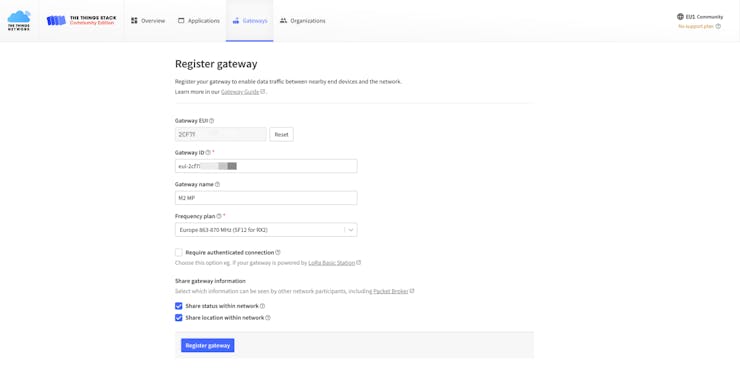
You can check the Gateway in the overview after successful registration.
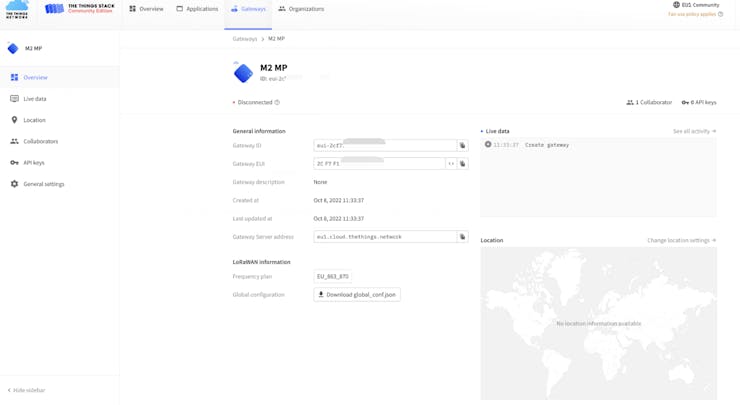
Gateway Configuration
Step 1: LoRa Network Settings
Navigate to LoRa > LoRa Network

Step 2: Set Mode to Packet Forward
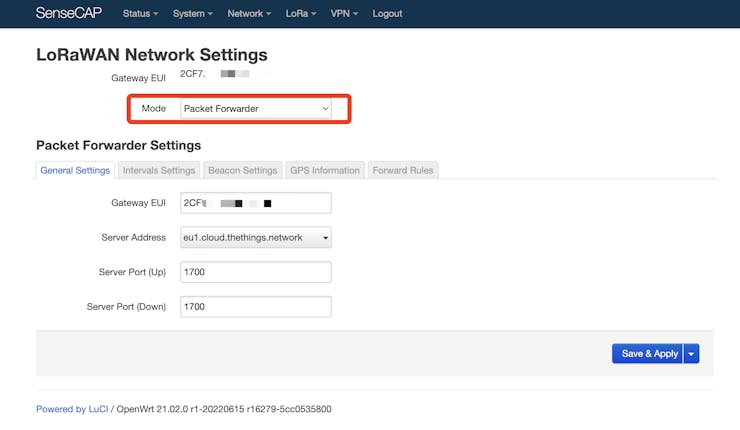
Step 3:Packet Forwarder Settings:
Gateway EUI: It will automatically get the EUI of the connected gateway
Server Address: For Semtech UDP Packet Forwarder use 'server-address' The 'server-address' is the address of your The Things Stack deployment. See Server Addresses for more info.
Server Port(Up/Down): The Up Port and Down Port are typically 1700.
Other settings can be left as default or can be changed to suit your requirements.
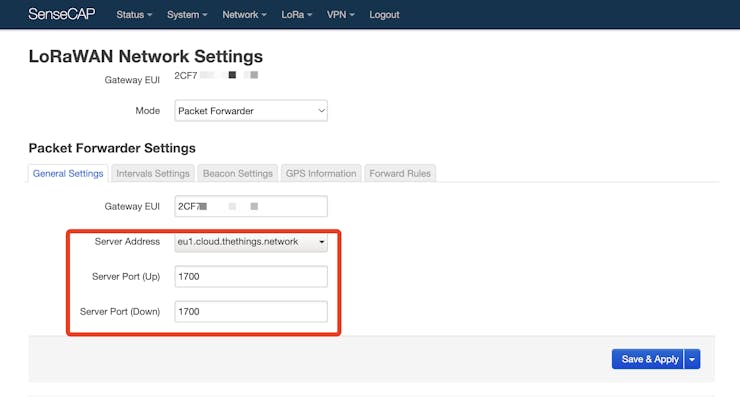
Click Save&Apply to apply your settings
Checking the Gateway Connection Status
After the settings are completed, we can view the live data of your gateway.
You can see that our gateway is connected to TTN now.
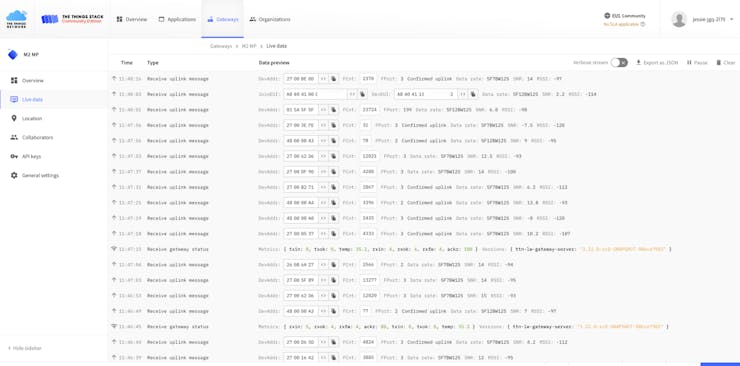
Gateway Sucess
After powering on the gateway, there are two ways for you to check the gateway working status:
LED Indicator Method
SenseCAP Mate APP Method
In the SenseCAP Mate App, Online status indicates Online when the gateway is connected to the network.
Bind the gateway
SenseCAP Mate APP supports device configuration and remote management.
Step 1: Download the SenseCAP Mate APP

Step 2: Log in to the APP If it is your first time using the SenseCAP platform, please register an account first.
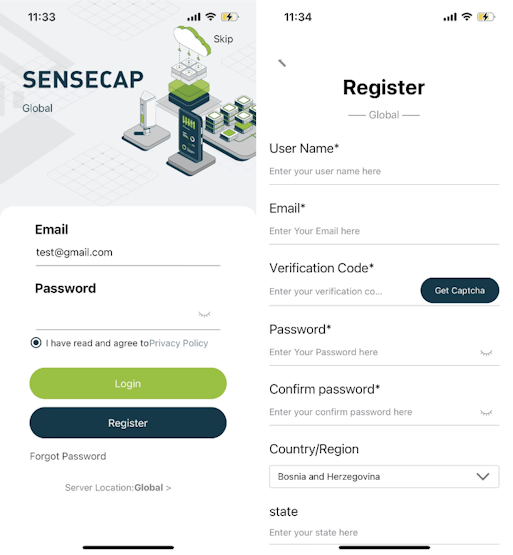
Step 3: Add the device
Click the + in the upper right corner and select Add device Then scan the QR code on your gateway label.

Set up your device name and location. Then confirm your settings. After successful binding, you will see your gateway in the Device directory.

Gateway USB Console Window
_____ _________ ____
/ ___/___ ____ ________ / ____/ | / __ \
\__ \/ _ \/ __ \/ ___/ _ \/ / / /| | / /_/ /
___/ / __/ / / (__ ) __/ /___/ ___ |/ ____/
/____/\___/_/ /_/____/\___/\____/_/ |_/_/
U-Boot 1.1.3-8-general (Aug 15 2022 - 12:56:22)
Board: Ralink APSoC DRAM: 128 MB
relocate_code Pointer at: 87fb8000
flash manufacture id: ef, device id 40 19
info id : ef info->jedec_id :40160000 buf[1]:40 buf[2]:19
info id : ef info->jedec_id :40170000 buf[1]:40 buf[2]:19
info id : ef info->jedec_id :40180000 buf[1]:40 buf[2]:19
info id : ef info->jedec_id :40190000 buf[1]:40 buf[2]:19
find flash: W25Q256FV
============================================
Ralink UBoot Version: 4.3.0.0
--------------------------------------------
ASIC 7628_MP (Port5<->None)
DRAM component: 1024 Mbits DDR, width 16
DRAM bus: 16 bit
Total memory: 128 MBytes
Flash component: SPI Flash
Date:Aug 15 2022 Time:12:56:22
============================================
icache: sets:512, ways:4, linesz:32 ,total:65536
dcache: sets:256, ways:4, linesz:32 ,total:32768
##### The CPU freq = 575 MHZ ####
estimate memory size =128 Mbytes
RESET MT7628 PHY!!!!!!
Please choose the operation:
0: Load system code then write to Flash via Serial.
1: Load system code to SDRAM via TFTP.
2: Load system code then write to Flash via TFTP.
3: Boot system code via Flash (default).
4: Entr boot command line interface.
7: Load Boot Loader code then write to Flash via Serial.
9: Load Boot Loader code then write to Flash via TFTP.
4 3 2 1 0
3: System Boot system code via Flash.
## Booting image at bc050000 ...
Image Name: MIPS OpenWrt Linux-5.4.143
Image Type: MIPS Linux Kernel Image (lzma compressed)
Data Size: 2035427 Bytes = 1.9 MB
Load Address: 80000000
Entry Point: 80000000
Verifying Checksum ... OK
Uncompressing Kernel Image ... OK
No initrd
## Transferring control to Linux (at address 80000000) ...
## Giving linux memsize in MB, 128
Starting kernel ...
[ 0.000000] Linux version 5.4.143 (builder000@three-body-univ) (gcc version 8.4.0 (OpenWrt GCC 8.4.0 r16279-5cc0535800)) #0 Tue Aug 31 22:20:08 2021
[ 0.000000] Board has DDR2
[ 0.000000] Analog PMU set to hw control
[ 0.000000] Digital PMU set to hw control
[ 0.000000] SoC Type: MediaTek MT7628AN ver:1 eco:2
[ 0.000000] printk: bootconsole [early0] enabled
[ 0.000000] CPU0 revision is: 00019655 (MIPS 24KEc)
[ 0.000000] MIPS: machine is SenseCAP WM7628N
[ 0.000000] Initrd not found or empty - disabling initrd
[ 0.000000] Primary instruction cache 64kB, VIPT, 4-way, linesize 32 bytes.
[ 0.000000] Primary data cache 32kB, 4-way, PIPT, no aliases, linesize 32 bytes
[ 0.000000] Zone ranges:
[ 0.000000] Normal [mem 0x0000000000000000-0x0000000007ffffff]
[ 0.000000] Movable zone start for each node
[ 0.000000] Early memory node ranges
[ 0.000000] node 0: [mem 0x0000000000000000-0x0000000007ffffff]
[ 0.000000] Initmem setup node 0 [mem 0x0000000000000000-0x0000000007ffffff]
[ 0.000000] Built 1 zonelists, mobility grouping on. Total pages: 32480
[ 0.000000] Kernel command line: console=ttyS0,57600 rootfstype=squashfs,jffs2
[ 0.000000] Dentry cache hash table entries: 16384 (order: 4, 65536 bytes, linear)
[ 0.000000] Inode-cache hash table entries: 8192 (order: 3, 32768 bytes, linear)
[ 0.000000] Writing ErrCtl register=0005fe26
[ 0.000000] Readback ErrCtl register=0005fe26
[ 0.000000] mem auto-init: stack:off, heap alloc:off, heap free:off
[ 0.000000] Memory: 122236K/131072K available (4827K kernel code, 201K rwdata, 1072K rodata, 1188K init, 198K bss, 8836K reserved, 0K cma-reserved)
[ 0.000000] SLUB: HWalign=32, Order=0-3, MinObjects=0, CPUs=1, Nodes=1
[ 0.000000] NR_IRQS: 256
[ 0.000000] intc: using register map from devicetree
[ 0.000000] random: get_random_bytes called from start_kernel+0x358/0x54c with crng_init=0
[ 0.000000] CPU Clock: 580MHz
[ 0.000000] timer_probe: no matching timers found
[ 0.000000] clocksource: MIPS: mask: 0xffffffff max_cycles: 0xffffffff, max_idle_ns: 6590553264 ns
[ 0.000010] sched_clock: 32 bits at 290MHz, resolution 3ns, wraps every 7405115902ns
[ 0.015386] Calibrating delay loop... 385.02 BogoMIPS (lpj=770048)
[ 0.059457] pid_max: default: 32768 minimum: 301
[ 0.068790] Mount-cache hash table entries: 1024 (order: 0, 4096 bytes, linear)
[ 0.083118] Mountpoint-cache hash table entries: 1024 (order: 0, 4096 bytes, linear)
[ 0.104862] clocksource: jiffies: mask: 0xffffffff max_cycles: 0xffffffff, max_idle_ns: 7645041785100000 ns
[ 0.124063] futex hash table entries: 256 (order: -1, 3072 bytes, linear)
[ 0.137575] pinctrl core: initialized pinctrl subsystem
[ 0.148977] NET: Registered protocol family 16
[ 0.193003] workqueue: max_active 576 requested for napi_workq is out of range, clamping between 1 and 512
[ 0.215732] clocksource: Switched to clocksource MIPS
[ 0.227050] NET: Registered protocol family 2
[ 0.235825] IP idents hash table entries: 2048 (order: 2, 16384 bytes, linear)
[ 0.250734] tcp_listen_portaddr_hash hash table entries: 512 (order: 0, 4096 bytes, linear)
[ 0.267211] TCP established hash table entries: 1024 (order: 0, 4096 bytes, linear)
[ 0.282289] TCP bind hash table entries: 1024 (order: 0, 4096 bytes, linear)
[ 0.296215] TCP: Hash tables configured (established 1024 bind 1024)
[ 0.308921] UDP hash table entries: 256 (order: 0, 4096 bytes, linear)
[ 0.321766] UDP-Lite hash table entries: 256 (order: 0, 4096 bytes, linear)
[ 0.335865] NET: Registered protocol family 1
[ 0.344401] PCI: CLS 0 bytes, default 32
[ 0.357039] workingset: timestamp_bits=14 max_order=15 bucket_order=1
[ 0.378226] squashfs: version 4.0 (2009/01/31) Phillip Lougher
[ 0.389946] jffs2: version 2.2 (NAND) (SUMMARY) (LZMA) (RTIME) (CMODE_PRIORITY) (c) 2001-2006 Red Hat, Inc.
[ 0.428207] mt7621_gpio 10000600.gpio: registering 32 gpios
[ 0.439442] mt7621_gpio 10000600.gpio: registering 32 gpios
[ 0.450664] mt7621_gpio 10000600.gpio: registering 32 gpios
[ 0.461922] Serial: 8250/16550 driver, 3 ports, IRQ sharing disabled
[ 0.475647] printk: console [ttyS0] disabled
[ 0.484090] 10000c00.uartlite: ttyS0 at MMIO 0x10000c00 (irq = 28, base_baud = 2500000) is a 16550A
[ 0.501892] printk: console [ttyS0] enabled
[ 0.501892] printk: console [ttyS0] enabled
[ 0.518378] printk: bootconsole [early0] disabled
[ 0.518378] printk: bootconsole [early0] disabled
[ 0.537671] 10000d00.uart1: ttyS1 at MMIO 0x10000d00 (irq = 29, base_baud = 2500000) is a 16550A
[ 0.555908] 10000e00.uart2: ttyS2 at MMIO 0x10000e00 (irq = 30, base_baud = 2500000) is a 16550A
[ 0.574751] spi-mt7621 10000b00.spi: sys_freq: 193333333
[ 0.602679] spi-nor spi0.0: w25q256 (32768 Kbytes)
[ 0.612264] 5 fixed-partitions partitions found on MTD device spi0.0
[ 0.624859] Creating 5 MTD partitions on "spi0.0":
[ 0.634360] 0x000000000000-0x000000030000 : "u-boot"
[ 0.645282] 0x000000030000-0x000000040000 : "u-boot-env"
[ 0.656872] 0x000000040000-0x000000050000 : "factory"
[ 0.668075] 0x000000050000-0x000000a50000 : "firmware"
[ 0.682700] 2 uimage-fw partitions found on MTD device firmware
[ 0.694498] Creating 2 MTD partitions on "firmware":
[ 0.704350] 0x000000000000-0x0000001f0f23 : "kernel"
[ 0.715253] 0x0000001f0f23-0x000000a00000 : "rootfs"
[ 0.726129] mtd: device 5 (rootfs) set to be root filesystem
[ 0.737446] 0x000000a50000-0x000002000000 : "rootfs_data"
[ 0.750466] libphy: Fixed MDIO Bus: probed
[ 0.772137] rt3050-esw 10110000.esw: link changed 0x00
[ 0.784527] mtk_soc_eth 10100000.ethernet eth0: mediatek frame engine at 0xb0100000, irq 5
[ 0.802886] NET: Registered protocol family 10
[ 0.816165] Segment Routing with IPv6
[ 0.823627] NET: Registered protocol family 17
[ 0.832515] 8021q: 802.1Q VLAN Support v1.8
[ 0.852388] VFS: Mounted root (squashfs filesystem) readonly on device 31:5.
[ 0.873150] Freeing unused kernel memory: 1188K
[ 0.882145] This architecture does not have kernel memory protection.
[ 0.894899] Run /sbin/init as init process
[ 1.483737] random: fast init done
[ 2.090287] init: Console is alive
[ 2.097442] init: - watchdog -
[ 4.694447] kmodloader: loading kernel modules from /etc/modules-boot.d/*
[ 4.833007] usbcore: registered new interface driver usbfs
[ 4.844022] usbcore: registered new interface driver hub
[ 4.854679] usbcore: registered new device driver usb
[ 4.872288] ehci_hcd: USB 2.0 'Enhanced' Host Controller (EHCI) Driver
[ 4.887071] ehci-fsl: Freescale EHCI Host controller driver
[ 4.900325] ehci-platform: EHCI generic platform driver
[ 4.921071] phy phy-10120000.usbphy.0: remote usb device wakeup disabled
[ 4.934356] phy phy-10120000.usbphy.0: UTMI 16bit 30MHz
[ 4.944711] ehci-platform 101c0000.ehci: EHCI Host Controller
[ 4.956132] ehci-platform 101c0000.ehci: new USB bus registered, assigned bus number 1
[ 4.971969] ehci-platform 101c0000.ehci: irq 26, io mem 0x101c0000
[ 4.999744] ehci-platform 101c0000.ehci: USB 2.0 started, EHCI 1.00
[ 5.013248] hub 1-0:1.0: USB hub found
[ 5.021208] hub 1-0:1.0: 1 port detected
[ 5.033548] ehci-pci: EHCI PCI platform driver
[ 5.046165] ohci_hcd: USB 1.1 'Open' Host Controller (OHCI) Driver
[ 5.060281] ohci-platform: OHCI generic platform driver
[ 5.070971] ohci-platform 101c1000.ohci: Generic Platform OHCI controller
[ 5.084483] ohci-platform 101c1000.ohci: new USB bus registered, assigned bus number 2
[ 5.100301] ohci-platform 101c1000.ohci: irq 26, io mem 0x101c1000
[ 5.176824] hub 2-0:1.0: USB hub found
[ 5.184790] hub 2-0:1.0: 1 port detected
[ 5.196633] uhci_hcd: USB Universal Host Controller Interface driver
[ 5.211107] ohci-pci: OHCI PCI platform driver
[ 5.264214] sdhci: Secure Digital Host Controller Interface driver
[ 5.276521] sdhci: Copyright(c) Pierre Ossman
[ 5.286564] sdhci-pltfm: SDHCI platform and OF driver helper
[ 5.302268] kmodloader: done loading kernel modules from /etc/modules-boot.d/*
[ 5.327183] init: - preinit -
Press the [1], [2], [3] or [4] key and hit [enter] to select the debug level
[ 7.963309] mount_root: loading kmods from internal overlay
[ 8.037097] kmodloader: loading kernel modules from //etc/modules-boot.d/*
[ 8.052675] kmodloader: done loading kernel modules from //etc/modules-boot.d/*
[ 9.737840] jffs2: notice: (435) jffs2_build_xattr_subsystem: complete building xattr subsystem, 277 of xdatum (271 unchecked, 4 orphan) and 318 of xref (6 dead, 0 orphan) found.
[ 9.770193] block: attempting to load /tmp/jffs_cfg/upper/etc/config/fstab
[ 9.794900] block: extroot: not configured
[ 10.217848] jffs2: notice: (433) jffs2_build_xattr_subsystem: complete building xattr subsystem, 277 of xdatum (271 unchecked, 4 orphan) and 318 of xref (6 dead, 0 orphan) found.
[ 10.251882] mount_root: loading kmods from internal overlay
[ 10.326972] kmodloader: loading kernel modules from /tmp/overlay/upper/etc/modules-boot.d/*
[ 10.349420] kmodloader: done loading kernel modules from /tmp/overlay/upper/etc/modules-boot.d/*
[ 11.317444] block: attempting to load /tmp/jffs_cfg/upper/etc/config/fstab
[ 11.338570] block: extroot: not configured
[ 11.348390] mount_root: switching to jffs2 overlay
[ 11.363668] overlayfs: upper fs does not support tmpfile.
[ 11.382863] urandom-seed: Seeding with /etc/urandom.seed
[ 11.533826] procd: - early -
[ 11.539813] procd: - watchdog -
[ 12.283902] procd: - watchdog -
[ 12.301795] procd: - ubus -
[ 12.489231] random: ubusd: uninitialized urandom read (4 bytes read)
[ 12.505864] random: ubusd: uninitialized urandom read (4 bytes read)
[ 12.519138] random: ubusd: uninitialized urandom read (4 bytes read)
[ 12.539860] procd: - init -
[ 14.079141] kmodloader: loading kernel modules from /etc/modules.d/*
[ 14.183569] tun: Universal TUN/TAP device driver, 1.6
[ 14.354781] i2c /dev entries driver
[ 14.373586] i2c-mt7621 10000900.i2c: clock 100 kHz
[ 14.434871] hidraw: raw HID events driver (C) Jiri Kosina
[ 14.508293] Bluetooth: Core ver 2.22
[ 14.515578] NET: Registered protocol family 31
[ 14.524407] Bluetooth: HCI device and connection manager initialized
[ 14.537006] Bluetooth: HCI socket layer initialized
[ 14.546672] Bluetooth: L2CAP socket layer initialized
[ 14.556710] Bluetooth: SCO socket layer initialized
[ 14.589626] urngd: v1.0.2 started.
[ 14.631000] Bluetooth: BNEP (Ethernet Emulation) ver 1.3
[ 14.641606] Bluetooth: BNEP filters: protocol multicast
[ 14.651968] Bluetooth: BNEP socket layer initialized
[ 14.707243] usbcore: registered new interface driver btusb
[ 14.733749] usbcore: registered new interface driver cdc_wdm
[ 14.760806] Loading modules backported from Linux version v5.10.42-0-g65859eca4dff
[ 14.775880] Backport generated by backports.git v5.10.42-1-0-gbee5c545
[ 14.840482] Bluetooth: HCI UART driver ver 2.3
[ 14.849355] Bluetooth: HCI UART protocol H4 registered
[ 14.859534] Bluetooth: HCI UART protocol BCSP registered
[ 14.905819] Bluetooth: HIDP (Human Interface Emulation) ver 1.2
[ 14.917639] Bluetooth: HIDP socket layer initialized
[ 14.977353] random: crng init done
[ 14.984154] random: 7 urandom warning(s) missed due to ratelimiting
[ 15.005741] Bluetooth: RFCOMM TTY layer initialized
[ 15.015503] Bluetooth: RFCOMM socket layer initialized
[ 15.025724] Bluetooth: RFCOMM ver 1.11
[ 15.088168] usbcore: registered new interface driver usbserial_generic
[ 15.101282] usbserial: USB Serial support registered for generic
[ 15.194217] xt_time: kernel timezone is -0000
[ 15.452494] mt76_wmac 10300000.wmac: ASIC revision: 76280001
[ 16.506007] mt76_wmac 10300000.wmac: Firmware Version: 20151201
[ 16.517817] mt76_wmac 10300000.wmac: Build Time: 20151201183641
[ 16.575752] mt76_wmac 10300000.wmac: firmware init done
[ 16.919822] PPP generic driver version 2.4.2
[ 16.932594] NET: Registered protocol family 24
[ 16.946611] usbcore: registered new interface driver qmi_wwan
[ 16.991470] usbcore: registered new interface driver option
[ 17.002691] usbserial: USB Serial support registered for GSM modem (1-port)
[ 17.079145] kmodloader: done loading kernel modules from /etc/modules.d/*
os version: 0.9.4-5
wan mac: 2c:f7:f1:1e:12:b2
[ 32.889594] rt3050-esw 10110000.esw: link changed 0x00
[ 38.325673] device eth0 entered promiscuous mode
[ 38.348145] br-lan: port 1(eth0.1) entered blocking state
[ 38.358908] br-lan: port 1(eth0.1) entered disabled state
[ 38.370033] device eth0.1 entered promiscuous mode
[ 38.457806] br-lan: port 1(eth0.1) entered blocking state
[ 38.468575] br-lan: port 1(eth0.1) entered forwarding state
[ 39.308279] IPv6: ADDRCONF(NETDEV_CHANGE): br-lan: link becomes ready
[ 79.164319] usb 1-1: new high-speed USB device number 2 using ehci-platform
[ 79.374581] option 1-1:1.0: GSM modem (1-port) converter detected
[ 79.387159] usb 1-1: GSM modem (1-port) converter now attached to ttyUSB0
[ 79.401522] option 1-1:1.1: GSM modem (1-port) converter detected
[ 79.413998] usb 1-1: GSM modem (1-port) converter now attached to ttyUSB1
[ 79.428423] option 1-1:1.2: GSM modem (1-port) converter detected
[ 79.440876] usb 1-1: GSM modem (1-port) converter now attached to ttyUSB2
[ 79.455260] option 1-1:1.3: GSM modem (1-port) converter detected
[ 79.467779] usb 1-1: GSM modem (1-port) converter now attached to ttyUSB3
[ 79.818775] qmi_wwan 1-1:1.4: cdc-wdm0: USB WDM device
[ 79.856212] qmi_wwan 1-1:1.4: Quectel EC25&EC21&EG91&EG95&EG06&EP06&EM06&BG96&AG35 work on RawIP mode
[ 79.925774] qmi_wwan 1-1:1.4 wwan0: register 'qmi_wwan' at usb-101c0000.ehci-1, WWAN/QMI device, 9a:4d:e7:b6:30:64
BUTTON PRESSED
OPEN CONFIG MODE
EXIT RECOVER
[ 135.062780] br-lan: port 2(wlan0-1) entered blocking state
[ 135.073770] br-lan: port 2(wlan0-1) entered disabled state
[ 135.085094] device wlan0-1 entered promiscuous mode
[ 168.900183] device wlan0-1 left promiscuous mode
[ 168.909562] br-lan: port 2(wlan0-1) entered disabled state
[ 170.517940] br-lan: port 2(wlan0) entered blocking state
[ 170.528558] br-lan: port 2(wlan0) entered disabled state
[ 170.539503] device wlan0 entered promiscuous mode
[ 170.732663] IPv6: ADDRCONF(NETDEV_CHANGE): wlan0: link becomes ready
[ 170.745582] br-lan: port 2(wlan0) entered blocking state
[ 170.756157] br-lan: port 2(wlan0) entered forwarding state
[ 449.741216] usb 1-1: USB disconnect, device number 2
[ 449.751572] option1 ttyUSB0: GSM modem (1-port) converter now disconnected from ttyUSB0
[ 449.767652] option 1-1:1.0: device disconnected
[ 449.777257] option1 ttyUSB1: GSM modem (1-port) converter now disconnected from ttyUSB1
[ 449.793329] option 1-1:1.1: device disconnected
[ 449.802940] option1 ttyUSB2: GSM modem (1-port) converter now disconnected from ttyUSB2
[ 449.819131] option 1-1:1.2: device disconnected
[ 449.828872] option1 ttyUSB3: GSM modem (1-port) converter now disconnected from ttyUSB3
[ 449.844995] option 1-1:1.3: device disconnected
[ 450.305233] qmi_wwan 1-1:1.4 wwan0: unregister 'qmi_wwan' usb-101c0000.ehci-1, WWAN/QMI device
[ 460.827881] usb 1-1: new high-speed USB device number 3 using ehci-platform
[ 461.043071] option 1-1:1.0: GSM modem (1-port) converter detected
[ 461.055579] usb 1-1: GSM modem (1-port) converter now attached to ttyUSB0
[ 461.069885] option 1-1:1.1: GSM modem (1-port) converter detected
[ 461.082449] usb 1-1: GSM modem (1-port) converter now attached to ttyUSB1
[ 461.096802] option 1-1:1.2: GSM modem (1-port) converter detected
[ 461.109247] usb 1-1: GSM modem (1-port) converter now attached to ttyUSB2
[ 461.123620] option 1-1:1.3: GSM modem (1-port) converter detected
[ 461.136083] usb 1-1: GSM modem (1-port) converter now attached to ttyUSB3
[ 461.678228] qmi_wwan 1-1:1.4: cdc-wdm0: USB WDM device
[ 461.739851] qmi_wwan 1-1:1.4: Quectel EC25&EC21&EG91&EG95&EG06&EP06&EM06&BG96&AG35 work on RawIP mode
[ 461.837003] qmi_wwan 1-1:1.4 wwan0: register 'qmi_wwan' at usb-101c0000.ehci-1, WWAN/QMI device, 9a:4d:e7:b6:30:64
[ 576.627820] device wlan0 left promiscuous mode
[ 576.636810] br-lan: port 2(wlan0) entered disabled state
[ 578.723501] br-lan: port 2(wlan0-1) entered blocking state
[ 578.734466] br-lan: port 2(wlan0-1) entered disabled state
[ 578.745784] device wlan0-1 entered promiscuous mode
[ 591.394335] device wlan0-1 left promiscuous mode
[ 591.403746] br-lan: port 2(wlan0-1) entered disabled state
[ 592.974416] br-lan: port 2(wlan0) entered blocking state
[ 592.985036] br-lan: port 2(wlan0) entered disabled state
[ 592.996003] device wlan0 entered promiscuous mode
[ 593.159341] IPv6: ADDRCONF(NETDEV_CHANGE): wlan0: link becomes ready
[ 593.172332] br-lan: port 2(wlan0) entered blocking state
[ 593.182932] br-lan: port 2(wlan0) entered forwarding state




